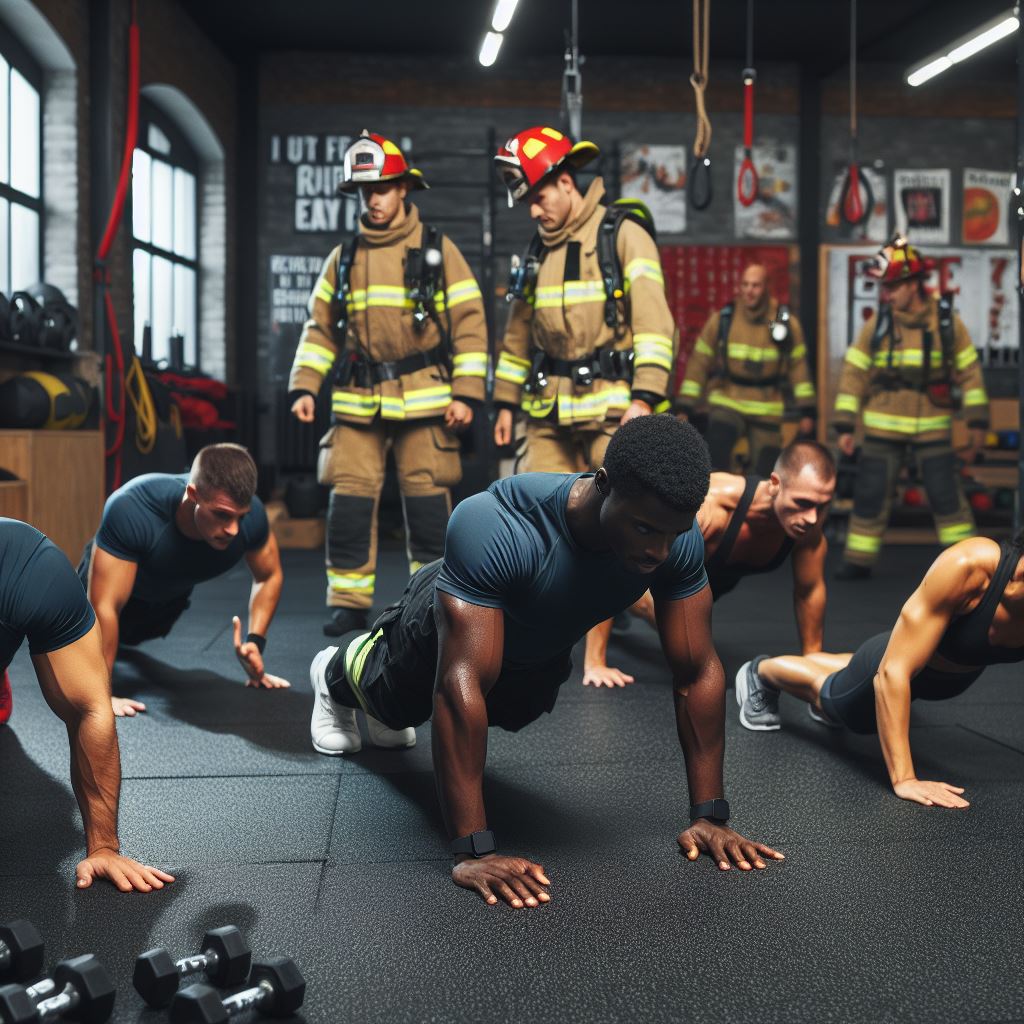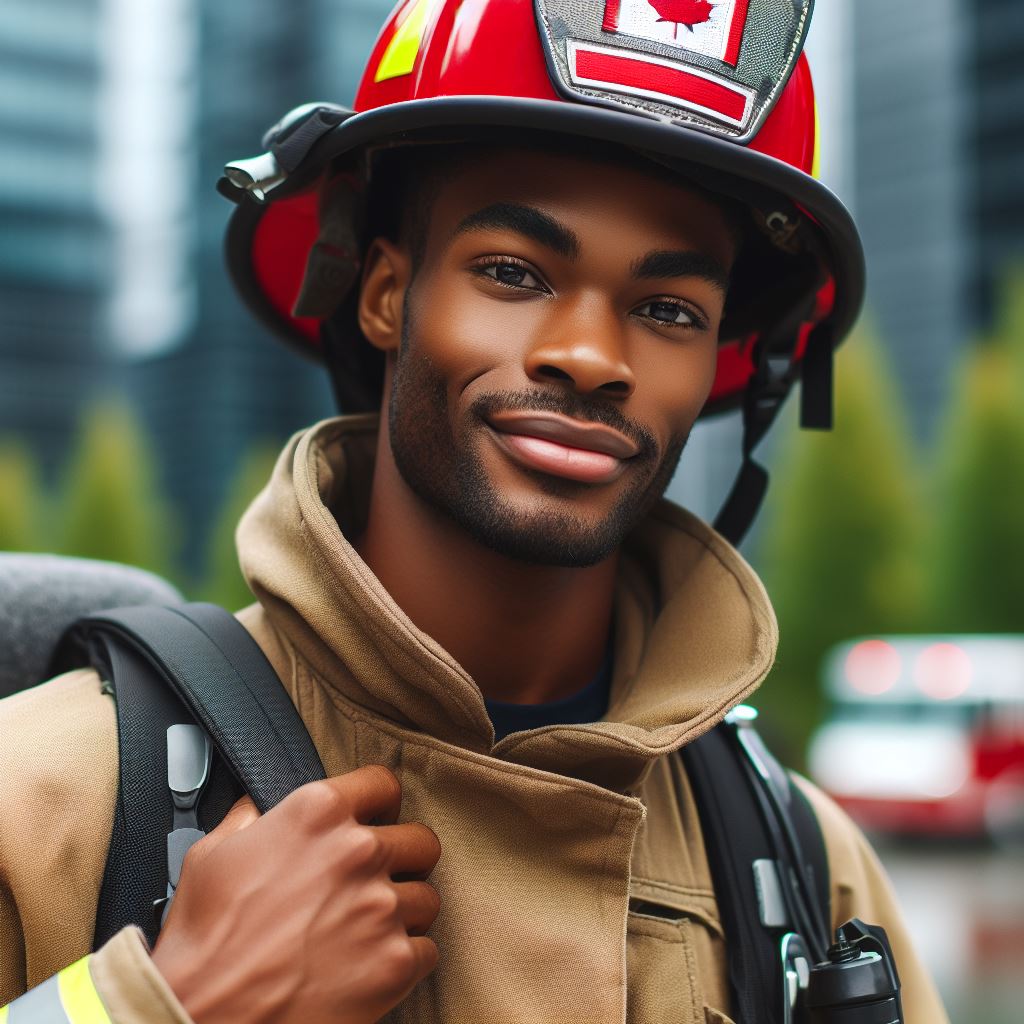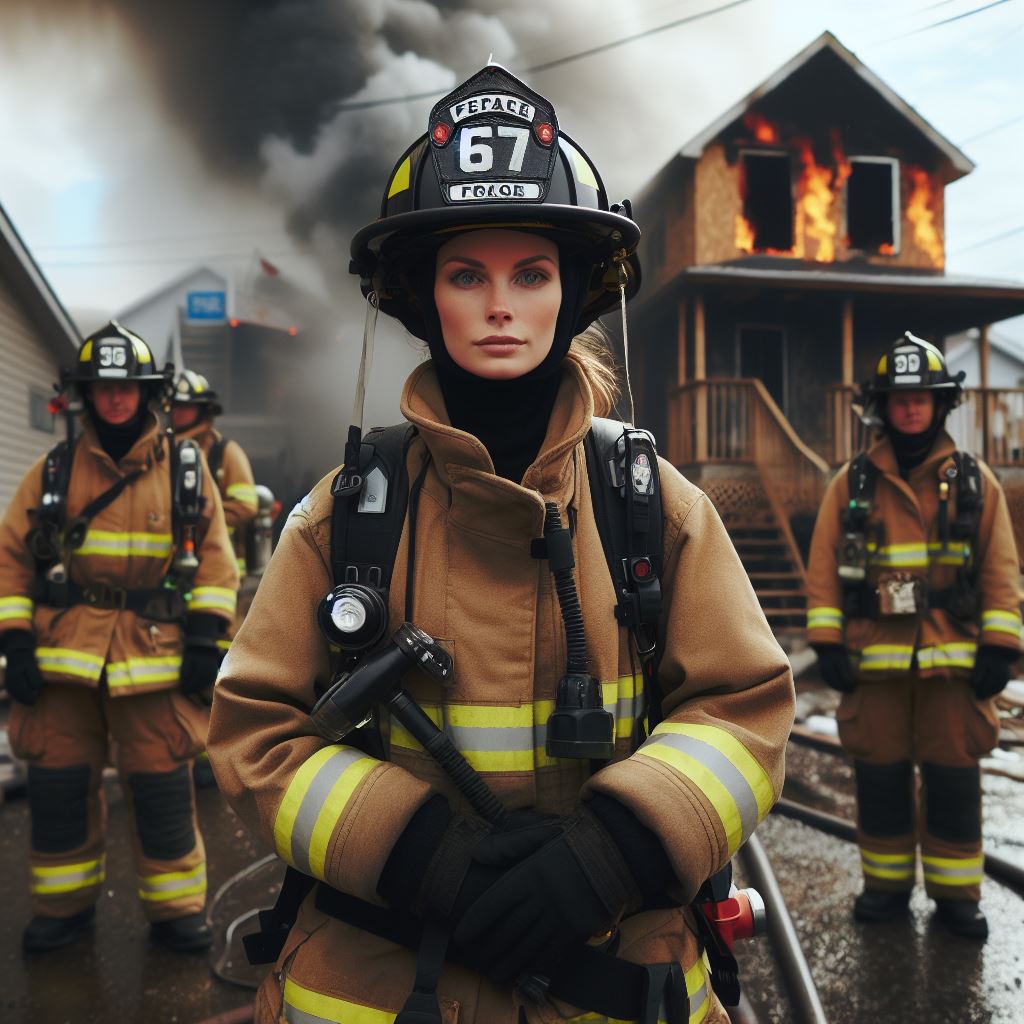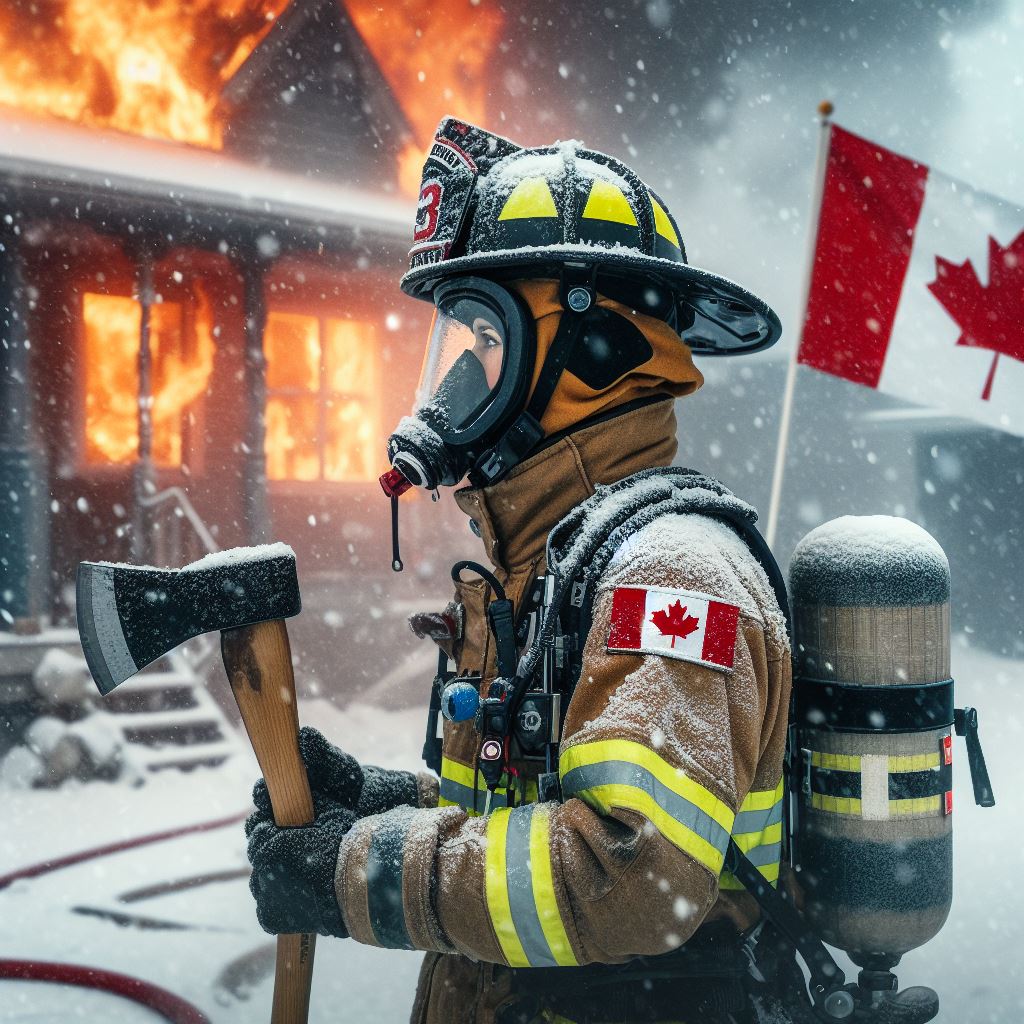Introduction
For aspiring firefighters, physical fitness plays a crucial role in their profession. It is essential to maintain optimal levels of fitness to perform the challenging and demanding tasks of firefighting.
In this blog post, we will explore various fitness tips and techniques that can help aspiring firefighters improve their physical abilities and overall health.
By following these tips, readers can expect to learn how to enhance their strength, endurance, cardiovascular health, and flexibility, all of which are important in the firefighting field.
As a firefighter, being physically fit is vital as it directly impacts performance and overall job effectiveness.
Firefighters face physically demanding situations regularly, including carrying heavy equipment, battling intense fires, and rescuing individuals in hazardous environments.
Therefore, staying in top physical condition is crucial for their safety and the safety of those they serve.
Throughout this blog post, we will delve into specific workout routines, exercises, and training techniques that aspiring firefighters can incorporate into their fitness regimens.
We will also discuss the importance of maintaining a balanced diet, getting enough rest and recovery, and overall wellness practices.
By the end of this blog post, readers will have a comprehensive understanding of how to prioritize their physical fitness as aspiring firefighters.
They will gain valuable insights and practical tips that can be easily integrated into their daily lives to enhance their performance, reduce the risk of injury, and ensure they are well-prepared to face the physical challenges of firefighting.
Understanding the Physical Demands of the Firefighting Profession
The various physical challenges firefighters face on the job
- Working in intense heat and unpredictable environments.
- Lifting and carrying heavy equipment and victims.
- Navigating narrow spaces and climbing ladders.
- Breathing through thick smoke and wearing heavy protective gear.
- Enduring long hours and physically demanding tasks.
The importance of cardiovascular endurance, strength, and flexibility in firefighting
- Cardiovascular endurance helps firefighters sustain energy levels during prolonged emergencies.
- Strength is necessary to carry equipment, execute rescue maneuvers, and maintain control in hazardous situations.
- Flexibility enables firefighters to reach confined spaces, perform stretches, and prevent injuries.
The need for functional fitness to perform tasks in unpredictable situations
- Functional fitness trains the body to perform daily life movements and firefighting tasks effectively.
- It enhances balance, coordination, and overall body control needed for quick decision-making.
- Firefighters must be able to adapt to the unique physical challenges they face on the job.
- Improving functional fitness prepares aspiring firefighters for a variety of unexpected scenarios they may encounter.
Tips for Fitness Training for Aspiring Firefighters
- Create a well-rounded fitness routine: Incorporate cardiovascular exercises, strength training, and flexibility exercises into your workouts.
- Focus on cardiovascular endurance: Engage in activities like running, swimming, or cycling to improve your stamina.
- Include strength training: Lift weights or perform bodyweight exercises to build muscle strength necessary for firefighting tasks.
- Don’t skip flexibility exercises: Prioritize stretching and mobility exercises to prevent injuries and enhance your range of motion.
- Train in functional movements: Mimic firefighting tasks like crawling, carrying, and ladder climbing to improve your overall performance.
- Simulate job-specific scenarios: Create workout routines that replicate the physical challenges you may encounter as a firefighter.
- Stay consistent and track your progress: Set goals, monitor your fitness journey, and adapt your training routine accordingly.
- Maintain a healthy lifestyle: Prioritize proper nutrition, hydration, and sufficient rest to support your physical fitness and overall well-being.
- Stay up to date with firefighting techniques and safety measures: Attend training programs and educational workshops to enhance your knowledge and skills.
- Seek professional guidance: Consult with fitness trainers or firefighters who can provide specific guidance tailored to your goals and aspirations.
By understanding the physical demands and training accordingly, aspiring firefighters can better prepare themselves for this demanding profession.
Consistent fitness training, focusing on cardiovascular endurance, strength, flexibility, and functional movements, will contribute to their overall effectiveness and resilience in unpredictable situations.
Remember, the path to becoming a firefighter goes beyond physical fitness alone, so maintaining a well-rounded lifestyle and staying informed are equally important.
Designing a Well-Rounded Fitness Routine
When it comes to aspiring firefighters, having a well-rounded fitness routine is of utmost importance.
This comprehensive fitness program should include various components such as cardiovascular exercise, strength training, and flexibility exercises.
By designing a tailored plan that takes into account individual fitness levels and preferences, aspiring firefighters can reach their fitness goals effectively.
The Significance of a Balanced Fitness Routine
A balanced fitness routine is essential for aspiring firefighters as it helps them build the necessary strength, endurance, and flexibility required for their physically demanding job.
It not only improves overall fitness levels but also enhances performance on the field, reduces injury risk, and promotes general well-being.
Components of a Comprehensive Fitness Program
Cardiovascular Exercise
- Engaging in activities like running, swimming, or cycling helps improve cardiovascular endurance.
- Performing cardiovascular exercises for at least 150 minutes a week can have significant health benefits.
Strength Training
- Include exercises like weightlifting, push-ups, pull-ups, and squats to enhance muscular strength.
- Aim to incorporate strength training exercises at least two days a week, targeting different muscle groups.
Flexibility Exercises
- Stretching exercises like yoga or Pilates improve flexibility, joint mobility, and muscular balance.
- Include both static and dynamic stretches, focusing on major muscle groups, before and after workouts.
Tips for Setting Goals and Creating a Tailored Plan
Assess Fitness Levels
- Before designing a fitness routine, aspiring firefighters should assess their current fitness levels.
- Evaluate cardiovascular endurance, strength, flexibility, and body composition to determine baseline fitness.
Set Realistic Goals
- Set specific, measurable, attainable, relevant, and time-bound (SMART) goals.
- Ensure that goals are challenging yet achievable, motivating individuals to work towards them consistently.
Tailor the Plan
- Consider individual preferences, time availability, and fitness level while creating a personalized fitness plan.
- Incorporate a mix of cardiovascular exercises, strength training, and flexibility exercises into the routine.
Gradually Increase Intensity
- Avoid overexertion or injury by gradually increasing the intensity and duration of exercises over time.
- Progressively challenge the body to adapt and improve by incorporating higher resistance or longer durations.
Seek Professional Guidance
- For aspiring firefighters who are unsure about designing their own fitness routine, consulting a fitness professional can be beneficial.
- A certified personal trainer or exercise physiologist can provide guidance and create a tailored plan.
Essentially, aspiring firefighters should prioritize designing a well-rounded fitness routine that includes cardiovascular exercise, strength training, and flexibility exercises.
By setting realistic goals, assessing fitness levels, and creating a personalized plan, aspiring firefighters can enhance their fitness levels and prepare themselves physically for the demands of their profession.
Cardiovascular Endurance Training
In order to prepare themselves for the physical demands of firefighting, aspiring firefighters must focus on improving their cardiovascular endurance.
This particular aspect of fitness is crucial for firefighters due to the intense nature of their job and the need to perform physically taxing tasks for prolonged periods of time.
Why is cardiovascular endurance crucial for aspiring firefighters?
Cardiovascular endurance is essential for firefighters as it allows them to sustain long periods of physical activity and work efficiently even under high-stress situations.
A strong cardiovascular system enables firefighters to deliver oxygen quickly to their muscles, helping them perform at their optimal level throughout their duties.
Effective Cardio Exercises for Aspiring Firefighters
When it comes to improving cardiovascular endurance, there are several exercises that aspiring firefighters can incorporate into their workout routines:
Unlock Your Career Potential
Visualize a clear path to success with our tailored Career Consulting service. Personalized insights in just 1-3 days.
Get Started- Running: Running is a classic cardio exercise that helps strengthen the heart and lungs. It can be easily adjusted to match individual fitness levels, making it suitable for beginners as well as advanced athletes.
- Swimming: Swimming is a low-impact exercise that provides a full-body workout while also being gentle on the joints. It can help improve both cardiovascular endurance and overall muscle strength.
- Cycling: Cycling is another great cardio exercise that can be performed outdoors or indoors on a stationary bike. It helps build lower body strength and enhances cardiovascular fitness.
- HIIT Workouts: High-Intensity Interval Training (HIIT) involves short bursts of intense exercise followed by brief periods of rest.
This type of workout improves cardiovascular endurance and also helps build muscular strength.
Simulating the Demands of Firefighting through Interval Training
Interval training is an effective way to replicate the demands of firefighting in a controlled environment.
By incorporating timed workouts and interval training into their fitness routines, aspiring firefighters can improve their cardiovascular endurance and better prepare for the challenges they may face during their future careers.
One example of interval training specifically designed to simulate firefighting demands is the “firefighter circuit.”
This circuit involves a combination of aerobic exercises such as running or cycling, coupled with high-intensity strength training exercises like burpees and kettlebell swings.
The circuit is performed for a set amount of time, with short rest periods in between each exercise.
Another approach is to incorporate timed workouts that mirror the average duration of a firefighting task. For instance, firefighters are often required to climb stairs carrying heavy equipment.
Aspiring firefighters can simulate this by performing stair-climbing exercises while wearing a weighted vest or carrying a backpack filled with sandbags.
They can gradually increase the duration or intensity of these workouts to further challenge themselves.
By consistently incorporating cardiovascular endurance training into their fitness routines, aspiring firefighters can improve their overall physical fitness, adapt to the demands of firefighting, and increase their chances of success during training and in the field.

Strength Training
Strength training is crucial for aspiring firefighters as it helps them meet the physical demands of firefighting.
By enhancing overall strength, firefighters can perform their duties effectively and minimize the risk of injuries.
Tips for incorporating strength training
Here are some important tips for incorporating strength training into your fitness routine:
- Focus on Compound Exercises: Compound exercises involve multiple muscle groups and mimic real-life movements, making them ideal for firefighters. Squats, deadlifts, push-ups, and pull-ups are excellent compound exercises.
- Build Overall Strength: Compound exercises not only target specific muscles but also develop overall strength and coordination. This is crucial for firefighters who need to handle heavy equipment and perform physically demanding tasks.
- Gradually Increase Weights: Start with lighter weights and gradually increase the load to avoid straining or injuring your muscles. It’s important to progress steadily to build strength effectively.
- Incorporate Functional Movements: Firefighting tasks require functional movements like carrying, lifting, and dragging. Incorporate exercises that simulate these movements, such as farmer’s walks, sled pushes, and sandbag carries.
- Engage Core Muscles: A strong core is essential for stability and balance. Include exercises like planks, Russian twists, and bicycle crunches to strengthen your core muscles.
- Don’t Neglect Cardiovascular Training: While strength training is crucial, don’t forget to include cardiovascular exercises to improve endurance. Firefighting requires sustained physical effort, so activities like running, swimming, or cycling are beneficial.
- Choose a Balanced Routine: Design a workout schedule that includes both strength training and cardiovascular exercises to achieve a well-rounded fitness level. Strive for a balanced approach to improve overall performance.
- Pay Attention to Proper Form: Correct form is vital to prevent injuries and get the most out of your workouts. If you’re unsure about proper technique, consider working with a qualified trainer.
- Allow Ample Rest and Recovery: Strength training breaks down your muscles, and they need time to rebuild and grow stronger. Allow for adequate rest and recovery days in your fitness plan.
- Track Your Progress: Keep a record of your workouts, noting the weights, sets, and repetitions. Tracking your progress can help you set goals and stay motivated on your fitness journey.
In fact, strength training is essential for aspiring firefighters to meet the physical demands of their challenging profession.
By incorporating compound exercises, gradually increasing weights, and focusing on functional movements, firefighters can develop the strength, endurance, and coordination required for firefighting tasks.
Remember to maintain proper form, balance your routine, and allow sufficient rest and recovery for optimal results.
Stay committed, track your progress, and embrace a fitness mindset as you work towards becoming a successful firefighter.
Read: Top Firefighting Schools Across Canada
Flexibility and Mobility Training
Flexibility and mobility training are crucial for aspiring firefighters to prevent injuries and enhance performance.
Significance of flexibility and mobility in preventing injuries and enhancing performance
It is essential to highlight the significance of flexibility and mobility in the training routine of aspiring firefighters.
In a physically demanding profession like firefighting, being flexible and mobile can make a significant difference in preventing injuries and increasing overall efficiency.
Suggestions incorporating stretching exercises and dynamic warm-up routines before workouts
One way to incorporate flexibility and mobility into the fitness routine is by including regular stretching exercises.
These exercises help in improving muscle flexibility, reducing muscle imbalances, and enhancing joint range of motion.
Before starting any workout, firefighters should consider incorporating dynamic warm-up routines.
Dynamic warm-ups involve movements that mimic the actions performed during the workout, which helps in preparing the body for the upcoming physical activity.
Recommendation of yoga, Pilates, or mobility exercises to improve joint range of motion and overall flexibility
Aside from traditional stretching and warm-ups, yoga is an excellent activity for improving both flexibility and mobility.
Yoga involves holding various poses that target different muscle groups and promote deep stretching, resulting in increased joint range of motion and overall flexibility.
Pilates is another form of exercise that focuses on strengthening the core muscles, improving stability, and enhancing overall body flexibility.
It incorporates controlled movements, breathing techniques, and specific exercises that target different muscle groups.
In addition to yoga and Pilates, incorporating mobility exercises is beneficial for aspiring firefighters. These exercises focus on improving the movement potential of the joints and their surrounding muscles.
Regularly performing mobility exercises helps in reducing muscle tightness, enhancing joint stability, and improving overall body control and coordination.
Firefighters should consider incorporating exercises that target all major joints, including shoulders, hips, knees, and ankles. These exercises can include leg swings, shoulder rotations, hip circles, and ankle mobility drills.
Overall, flexibility and mobility training are vital for aspiring firefighters as they can help prevent injuries and improve overall performance.
It is crucial to incorporate stretching exercises, dynamic warm-up routines, and activities like yoga, Pilates, and mobility exercises into the fitness routine.
By giving adequate attention to flexibility and mobility, aspiring firefighters can enhance their physical capabilities and better prepare themselves for the challenges of their profession.
Read: Essential Gear for Firefighters in Canada
Injury Prevention and Recovery
As aspiring firefighters, it is crucial to prioritize injury prevention in order to maintain long-term fitness. Here are some tips to help you stay injury-free and recover effectively:
Focus on Proper Form and Technique
- Ensure you learn and practice proper form and technique for all exercises.
- Proper form reduces the risk of injury and maximizes the effectiveness of your workouts.
- Seek guidance from a qualified trainer or coach to ensure correct form.
Gradually Increase Training Intensity
- Avoid sudden or excessive increases in training intensity, as it can lead to injuries.
- Progress gradually by slowly increasing the weight, duration, or frequency of your workouts.
- Listen to your body and give yourself enough time to adapt and recover
Incorporate Rest Days
- Rest is an essential part of any fitness program and helps prevent overuse injuries.
- Include at least one or two rest days per week to give your body time to recover and repair.
- Use rest days to focus on light activities, stretching, and allowing your muscles to rejuvenate.
Utilize Recovery Techniques
- Explore various recovery techniques that can help reduce muscle soreness and aid in recovery.
- Foam rolling, stretching, and using a massage ball can improve flexibility and circulation.
- Consider incorporating techniques like yoga, meditation, or deep breathing to relax and destress.
Listen to Your Body
- Pay attention to any signs of pain, discomfort, or fatigue during your training sessions.
- If something doesn’t feel right, don’t push through it. Rest or modify your workout accordingly.
- Ignoring warning signs can lead to more severe injuries that may hinder your progress in the long run.
Seek Appropriate Medical Attention
- If you experience an injury or persistent pain, seek medical attention promptly.
- Consult a healthcare professional who specializes in sports medicine or rehabilitation.
- Proper diagnosis and treatment can prevent further damage and speed up your recovery process.
Remember, injury prevention and recovery are vital for maintaining your fitness journey as an aspiring firefighter.
By prioritizing proper form, gradual progression, rest, and seeking medical attention when needed, you can minimize the risk of injuries and stay on track towards achieving your goals.
Read: Ethical Dilemmas Faced by Policemen
Mental and Emotional Fitness
Acknowledgement of the mental and emotional challenges faced by firefighters
Firefighting is a mentally and emotionally demanding profession. Aspiring firefighters must not only focus on physical fitness but also prioritize their mental and emotional well-being.
Understanding the mental and emotional challenges faced by firefighters is crucial in preparing for the job and maintaining long-term success.
The importance of stress management techniques, resilience, and maintaining a positive mindset
One of the key aspects of mental and emotional fitness is stress management.
Firefighters are exposed to high-stress situations regularly, and it is essential to develop effective techniques to cope with this pressure.
Learning stress management techniques such as deep breathing, progressive muscle relaxation, or guided imagery can significantly improve an aspiring firefighter’s ability to handle stressful situations.
Resilience is another vital component of mental and emotional fitness. Firefighters often face adversity, including traumatic events and witnessing human suffering.
Building resilience can help firefighters bounce back from difficult experiences and maintain their effectiveness.
Developing resilience can be achieved through activities such as physical exercise, maintaining a healthy lifestyle, and cultivating strong support networks.
Furthermore, maintaining a positive mindset plays a crucial role in mental and emotional fitness.
Positive thinking can help firefighters stay motivated, optimistic, and focused. It is important to cultivate positivity by surrounding themselves with supportive individuals and engaging in activities they enjoy.
Engaging in hobbies or pursuing personal interests can serve as a positive outlet for stress and provide a much-needed break from the demands of firefighting.
Suggested activities such as meditation, mindfulness, and seeking support from peers or professionals
One effective way to enhance mental and emotional fitness is through meditation.
Regular practice of meditation can help aspiring firefighters develop mental clarity, focus, and emotional stability.
By incorporating mindfulness techniques into their routine, firefighters can also improve their ability to stay present and focused during highly stressful situations.
Seeking support from peers and professionals is another important step towards maintaining mental and emotional well-being.
Firefighters should not hesitate to reach out to colleagues who have experienced similar challenges.
Peer support can provide a sense of understanding, empathy, and guidance.
Additionally, seeking professional help such as therapy or counseling can offer a safe space to discuss feelings, concerns, and any challenges faced on the job.
In general, mental and emotional fitness is a critical aspect of preparing for a career in firefighting.
Acknowledging the challenges, developing stress management techniques, resilience, and maintaining a positive mindset are all important for aspiring firefighters.
Activities like meditation, mindfulness, and seeking support from peers or professionals can significantly contribute to an aspiring firefighter’s mental and emotional well-being.
Read: Canadian Police Forces and Diversity
Learn More: Historic Fires and Lessons Learned
Conclusion
Aspiring firefighters can benefit greatly from following these key fitness tips. First, focus on building strength and endurance through exercises like weight lifting, running, and cardio workouts.
Additionally, prioritize flexibility and mobility by incorporating stretching and yoga into your routine.
Remember to also pay attention to your mental well-being by practicing stress management techniques and seeking support when needed.
Lastly, maintain a balanced and nutritious diet to fuel your body properly.
It is crucial to understand that a well-rounded fitness routine plays a vital role in achieving success in the firefighting profession.
Firefighters face physically demanding tasks that require strength, endurance, and agility.
By incorporating these fitness tips into their daily lives, aspiring firefighters can prepare themselves for the challenges that lie ahead.
To drive this point further, it is essential to encourage readers to implement these tips and seek professional guidance if needed.
Personal trainers and fitness experts can provide customized training plans and expertise to help aspiring firefighters reach their fitness goals.
Remember, fitness is a lifelong journey, and it is important to continually strive for improvement and adapt to new challenges.
By adopting these fitness tips and staying committed to their physical and mental well-being, aspiring firefighters can increase their chances of success in the firefighting profession.
So, lace up your shoes, grab your mat, and fuel your body with nutritious food.
Get ready to conquer the physical demands that come with being a firefighter and make your dreams a reality.




